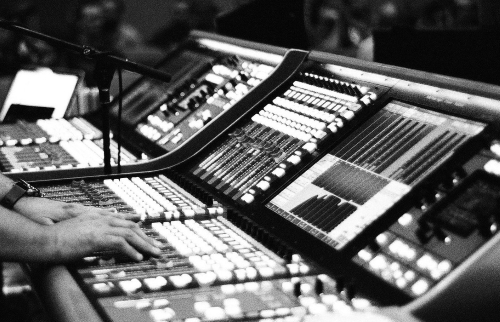
Get Vocals Dialed In To Your Own Voice Before Listening To Other Instruments In The PA
I rarely mix anything before I’ve listened to the vocal microphones in the system with my own voice. Hearing how the audio system reproduces my own voice can help me greatly to determine the upper limits and maximum volume of a PA.
There’s something about the dynamics of my own live vocal that can help me figure where the PA is going to feel loud, how the crossover points are going to affect the mix, and what volume I need to build up the other mix components to still keep the vocal prevalent in a mix.
Get Good Drum Sounds
OK, for all of you mixing in purely acoustic or liturgical situations, you can take a breath for a moment. But for the rest of you: For the love of all that’s holy, please get the drums right.
Again, I’ve devoted much time discussing this over the years but if you ignore everything else I ever say, please pay attention to this point, good drum sounds matter to a mix. Invest some time and a maybe a few bucks on some new drumheads. It matters.
Focus On Layering The Mix As You Build It
Seriously, do the billions of tracks the band is sending just make the mix fatiguing to the listener? I’ll wager that it does. You must find a definite place for all the sounds that are going to hit the audience. Work with your music team to make sure you’ve got some space in your mix. Every breath and gap doesn’t actually need to be filled with content.
If you didn’t like that one, here’s even more audio heresy for you: Sometimes a breath in the onslaught of music information might be exactly what’s needed to let people absorb what you’re putting out.
Get The Mix As Good As It Gets And Bask In The Glory
Too many engineers can’t quit fiddling around with their mix. Get better at knowing when your mix is as good as it’s going to get.
You heard me—quit trying to make huge improvements and mix what you’ve got. A great mix is a piece of art, but tell me one artist that has ever felt like their art was actually finished. We have to be OK knowing that a mix can always be improved but does it actually NEED to be?
Mix Like There’s No Tomorrow
You are mixing a living, breathing thing. Act like it. Get involved with the live creation going on in your space and be a part of the art. The audio console is an instrument, one that’s just as important as the instruments on stage. Don’t be afraid to manage your mix in accordance with the live craft coming from the stage.
I’ve seen many concerts and accompanied fellow engineers at many front of house locations, and the guys with the worst mixes are always those who seem detached with what’s coming from the stage. I’ve actually seen several engineers standing at the console during an event with their hands in their pockets.
Hmmm, perhaps that’s why they usually have a terrible sounding mix?
Here’s a thought: Mix every event like it’s your last time. Can you stand back afterwards feeling like you didn’t leave anything on the table? Start challenging yourself in that manner and watch your mixes improve.
Don’t Use Your Mix To Prove Something
All the gear, time, effort, and resources are only here to help communicate a message. NOT to prove how cool we are or to show off our expertise. If your motive is to satisfy your ego, step away from the mix.
I’ve discovered that my mixes are generally at their worst when I’m mixing to prove a point or mixing out of the wrong motivation. I’m almost always happier when my mixes get back in line with the bigger picture of what we’re trying to create as a team.
This list is by no means comprehensive. In fact, each point could actually be a blog on its own. But when it comes to creating a good mix, there is nothing that can be overlooked. Phoning it in just doesn’t cut it. Hopefully these items can get you thinking about what you can do in your own world of rock. Cheers.
Read and comment on the original article here.
